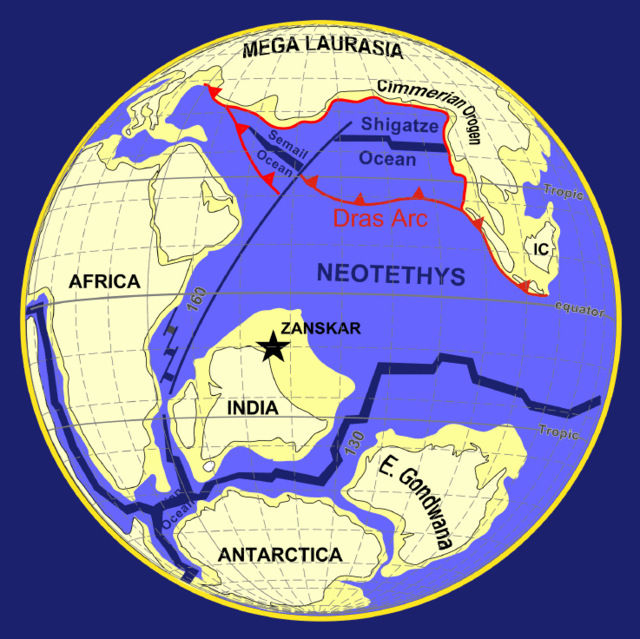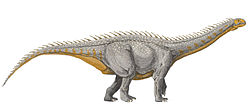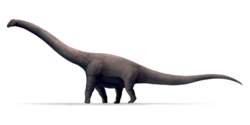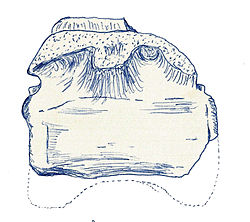List of Indian and Madagascan dinosaurs
From Wikipedia, the free encyclopedia
This is a list of non-avian dinosaurs whose remains have been recovered from the Indian subcontinent or Madagascar. Though widely separated today, the Indian subcontinent and Madagascar were connected throughout much of the Mesozoic and shared similar dinosaur faunas, distinct from what has been found on other modern African and Asian landmasses.

The Indian fossil record of dinosaurs is good, with fossils coming from the entire Mesozoic era – starting with the Triassic period (a geological period that started 251.9 million years ago and continued till 201.3 million years ago), to the Jurassic period (201 million years ago to 145 million years ago) and Cretaceous period (from 145 million years ago to 66 million years ago), when globally all non-avian dinosaurs and 65 per cent of all life became extinct. Madagascar also preserves various unique dinosaurs from the Jurassic and Cretaceous.
Criteria for inclusion
- The genus must appear on the List of dinosaur genera.
- At least one named species of the creature must have been found in the Indian subcontinent or Madagascar.
- This list is a complement to Category:Dinosaurs of India and Madagascar.
List of Indian and Madagascan dinosaurs
Valid genera
| Name | Year | Formation | Location | Notes | Images |
|---|---|---|---|---|---|
| Alwalkeria | 1994 | Lower Maleri Formation (Late Triassic, Carnian) | Possessed different types of teeth in its upper jaw |  | |
| Archaeodontosaurus | 2005 | Isalo III Formation (Middle Jurassic, Bajocian to Bathonian) | Retained "prosauropod"-like teeth despite its late age |  | |
| Barapasaurus | 1975 | Kota Formation (Early Jurassic, Sinemurian to Pliensbachian) | Several individuals have been found associated with tree trunks, which may represent the aftermath of a flood[1] |  | |
| Brachypodosaurus | 1934 | Lameta Formation (Late Cretaceous, Maastrichtian) | Has been suggested to be a thyreophoran, but such an identification is unlikely | ||
| Bruhathkayosaurus | 1987 | Kallamedu Formation (Late Cretaceous, Maastrichtian) | Reportedly exceptionally large but its fossils have been lost.[2] Its bones have been informally speculated to be misidentified tree trunks[3][4][5] but later research suggests at least the tibia is real[6] |  | |
| Coeluroides | 1933 | Lameta Formation (Late Cretaceous, Maastrichtian) | Potentially synonymous with Ornithomimoides[7] |  | |
| Compsosuchus | 1933 | Lameta Formation (Late Cretaceous, Maastrichtian) | Has been suggested to be both an abelisaurid[8] and a noasaurid[9] |  | |
| Dahalokely | 2013 | Ambolafotsy Formation (Late Cretaceous, Turonian) | Shares features of both abelisaurids and noasaurids |  | |
| Dandakosaurus | 1982 | Kota Formation (Early Jurassic, Pliensbachian to Toarcian) | Poorly known but large for an early theropod |  | |
| Dryptosauroides | 1932 | Lameta Formation (Late Cretaceous, Maastrichtian) | Only known from six caudal vertebrae |  | |
| Indosaurus | 1933 | Lameta Formation (Late Cretaceous, Maastrichtian) | Had a characteristically thickened skull |  | |
| Indosuchus | 1933 | Lameta Formation (Late Cretaceous, Maastrichtian) | Its skull was flattened and topped by a short crest |  | |
| Isisaurus | 2003 | Lameta Formation (Late Cretaceous, Maastrichtian) | Unusually proportioned with a short, robust neck and long limbs |  | |
| Jainosaurus | 1995 | Lameta Formation (Late Cretaceous, Maastrichtian) | Originally named as a species of Antarctosaurus |  | |
| Jaklapallisaurus | 2011 | Upper Maleri Formation (Late Triassic, Norian to Rhaetian) | May have been closely related to South American sauropodomorphs[10] | ||
| Kotasaurus | 1988 | Kota Formation (Early Jurassic, Sinemurian to Pliensbachian) | The neural spines of its vertebrae were massively constructed, which is a basal trait |  | |
| Laevisuchus | 1933 | Lameta Formation (Late Cretaceous, Maastrichtian) | Only known from three vertebrae but can confidently be assigned to the Noasauridae[11] |  | |
| Lametasaurus | 1923 | Lameta Formation (Late Cretaceous, Maastrichtian) | Described based on now lost remains, it is currently seen as a possible chimera including theropod material and osteoderms of uncertain origin |  | |
| Lamplughsaura | 2007 | Upper Dharmaram Formation (Early Jurassic, Sinemurian) | Large and robustly built |  | |
| Lapparentosaurus | 1986 | Isalo III Formation (Middle Jurassic, Bathonian) | Relatively fast-growing as evidenced by the preservation of a large amount of fibrolamellar bone[12] |  | |
| Majungasaurus | 1955 | Maevarano Formation (Late Cretaceous, Maastrichtian) | Bite marks on several specimens have been found to perfectly match the teeth of this genus, suggesting cannibalistic tendencies[13] |  | |
| Masiakasaurus | 2001 | Maevarano Formation (Late Cretaceous, Maastrichtian) | Possessed procumbent teeth at the tips of its jaws which may indicate a feeding specialization |  | |
| Nambalia | 2011 | Upper Maleri Formation (Late Triassic, Norian to Rhaetian) | Known from the remains of two individuals | ||
| Narindasaurus | 2020 | Isalo III Formation (Middle Jurassic, Bathonian to Callovian) | The oldest known turiasaur |  | |
| Ornithomimoides | 1932 | Lameta Formation (Late Cretaceous, Maastrichtian) | Two species have been named, both from isolated vertebrae |  | |
| Orthogoniosaurus | 1931 | Lameta Formation (Late Cretaceous, Maastrichtian) | Only known from a single, fragmentary tooth | ||
| Pradhania | 2007 | Upper Dharmaram Formation (Early Jurassic, Sinemurian) | Closely related to Massospondylus[14] |  | |
| Rahiolisaurus | 2010 | Lameta Formation (Late Cretaceous, Maastrichtian) | Remains of multiple growth stages are known |  | |
| Rajasaurus | 2003 | Lameta Formation (Late Cretaceous, Maastrichtian) | Possessed a single, short horn on its forehead that may have been used for display and head-butting[15] |  | |
| Rapetosaurus | 2001 | Maevarano Formation (Late Cretaceous, Maastrichtian) | Known from almost the entire skeleton, including the skull |  | |
| Tharosaurus | 2023 | Jaisalmer Formation (Middle Jurassic, Bathonian) | The oldest dicraeosaurid, diplodocoid and neosauropod currently known |  | |
| Titanosaurus | 1877 | Kallakurichi Formation, Lameta Formation (Late Cretaceous, Maastrichtian) | Although only known from a few bones, this genus is the namesake of the Titanosauria and the Titanosauriformes |  | |
| Vahiny | 2014 | Maevarano Formation (Late Cretaceous, Maastrichtian) | May have been a rare component of its habitat due to the paucity of its remains |
Invalid and potentially valid genera
- Dravidosaurus blanfordi: Described as a stegosaur but has been suggested to be a plesiosaur. However, it has been reported that stegosaur remains from its time and place are being described.
- Jubbulpuria tenuis: Potentially synonymous with Laevisuchus.
- Rahonavis ostromi: A small feathered maniraptoran. It has been variously suggested to be a dromaeosaurid (possibly an unenlagiine), an avialan or outside both groups.
Timeline
This is a timeline of selected dinosaurs from the list above. Time is measured in Ma, megaannum, along the x-axis.

See also
References
Wikiwand - on
Seamless Wikipedia browsing. On steroids.



